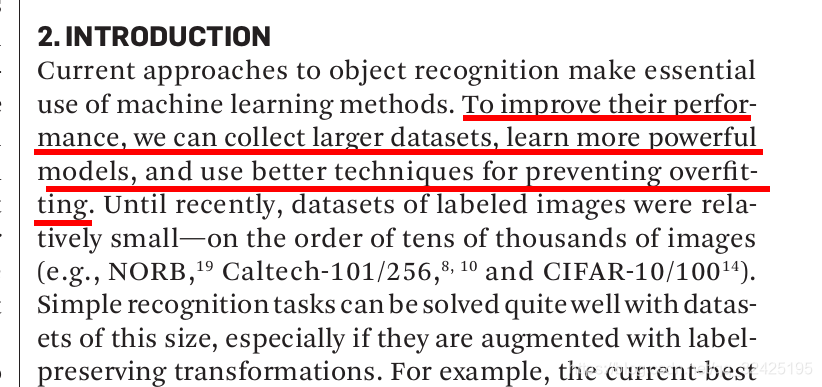1.网络实现源代码
class AlexNet(nn.Module):
def __init__(self, num_classes=1000):
super(AlexNet, self).__init__()
self.features = nn.Sequential(
nn.Conv2d(3, 64, kernel_size=11, stride=4, padding=2),
nn.ReLU(inplace=True),
nn.MaxPool2d(kernel_size=3, stride=2),
nn.Conv2d(64, 192, kernel_size=5, padding=2),
nn.ReLU(inplace=True),
nn.MaxPool2d(kernel_size=3, stride=2),
nn.Conv2d(192, 384, kernel_size=3, padding=1),
nn.ReLU(inplace=True),
nn.Conv2d(384, 256, kernel_size=3, padding=1),
nn.ReLU(inplace=True),
nn.Conv2d(256, 256, kernel_size=3, padding=1),
nn.ReLU(inplace=True),
nn.MaxPool2d(kernel_size=3, stride=2),
)
self.classifier = nn.Sequential(
nn.Dropout(),
nn.Linear(256 * 6 * 6, 4096),
nn.ReLU(inplace=True),
nn.Dropout(),
nn.Linear(4096, 4096),
nn.ReLU(inplace=True),
nn.Linear(4096, num_classes),
)
def forward(self, x):
x = self.features(x)
x = x.view(x.size(0), 256 * 6 * 6)
x = self.classifier(x)
return x
# -*- coding=UTF-8 -*-
import sys
import os
import random
import cv2
import math
import time
import numpy as np
import tensorflow as tf
import linecache
import string
import skimage
import imageio
# 输入数据
import input_data
mnist = input_data.read_data_sets("/tmp/data/", one_hot=True)
# 定义网络超参数
learning_rate = 0.001
training_iters = 200000
batch_size = 64
display_step = 20
# 定义网络参数
n_input = 784 # 输入的维度
n_classes = 10 # 标签的维度
dropout = 0.8 # Dropout 的概率
# 占位符输入
x = tf.placeholder(tf.types.float32, [None, n_input])
y = tf.placeholder(tf.types.float32, [None, n_classes])
keep_prob = tf.placeholder(tf.types.float32)
# 卷积操作
def conv2d(name, l_input, w, b):
return tf.nn.relu(tf.nn.bias_add( \
tf.nn.conv2d(l_input, w, strides=[1, 1, 1, 1], padding='SAME'),b) \
, name=name)
# 最大下采样操作
def max_pool(name, l_input, k):
return tf.nn.max_pool(l_input, ksize=[1, k, k, 1], \
strides=[1, k, k, 1], padding='SAME', name=name)
# 归一化操作
def norm(name, l_input, lsize=4):
return tf.nn.lrn(l_input, lsize, bias=1.0, alpha=0.001 / 9.0, beta=0.75, name=name)
# 定义整个网络
def alex_net(_X, _weights, _biases, _dropout):
_X = tf.reshape(_X, shape=[-1, 28, 28, 1]) # 向量转为矩阵
# 卷积层
conv1 = conv2d('conv1', _X, _weights['wc1'], _biases['bc1'])
# 下采样层
pool1 = max_pool('pool1', conv1, k=2)
# 归一化层
norm1 = norm('norm1', pool1, lsize=4)
# Dropout
norm1 = tf.nn.dropout(norm1, _dropout)
# 卷积
conv2 = conv2d('conv2', norm1, _weights['wc2'], _biases['bc2'])
# 下采样
pool2 = max_pool('pool2', conv2, k=2)
# 归一化
norm2 = norm('norm2', pool2, lsize=4)
# Dropout
norm2 = tf.nn.dropout(norm2, _dropout)
# 卷积
conv3 = conv2d('conv3', norm2, _weights['wc3'], _biases['bc3'])
# 下采样
pool3 = max_pool('pool3', conv3, k=2)
# 归一化
norm3 = norm('norm3', pool3, lsize=4)
# Dropout
norm3 = tf.nn.dropout(norm3, _dropout)
# 全连接层,先把特征图转为向量
dense1 = tf.reshape(norm3, [-1, _weights['wd1'].get_shape().as_list()[0]])
dense1 = tf.nn.relu(tf.matmul(dense1, _weights['wd1']) + _biases['bd1'], name='fc1')
# 全连接层
dense2 = tf.nn.relu(tf.matmul(dense1, _weights['wd2']) + _biases['bd2'], name='fc2')
# Relu activation
# 网络输出层
out = tf.matmul(dense2, _weights['out']) + _biases['out']
return out
# 存储所有的网络参数
weights = {
'wc1': tf.Variable(tf.random_normal([3, 3, 1, 64])),
'wc2': tf.Variable(tf.random_normal([3, 3, 64, 128])),
'wc3': tf.Variable(tf.random_normal([3, 3, 128, 256])),
'wd1': tf.Variable(tf.random_normal([4*4*256, 1024])),
'wd2': tf.Variable(tf.random_normal([1024, 1024])),
'out': tf.Variable(tf.random_normal([1024, 10]))
}
biases = {
'bc1': tf.Variable(tf.random_normal([64])),
'bc2': tf.Variable(tf.random_normal([128])),
'bc3': tf.Variable(tf.random_normal([256])),
'bd1': tf.Variable(tf.random_normal([1024])),
'bd2': tf.Variable(tf.random_normal([1024])),
'out': tf.Variable(tf.random_normal([n_classes]))
}
# 构建模型
pred = alex_net(x, weights, biases, keep_prob)
# 定义损失函数和学习步骤
cost = tf.reduce_mean(tf.nn.softmax_cross_entropy_with_logits(pred, y))
optimizer = tf.train.AdamOptimizer(learning_rate=learning_rate).minimize(cost)
# 测试网络
correct_pred = tf.equal(tf.argmax(pred,1), tf.argmax(y,1))
accuracy = tf.reduce_mean(tf.cast(correct_pred, tf.float32))
# 初始化所有的共享变量
init = tf.initialize_all_variables()
# 开启一个训练
with tf.Session() as sess:
sess.run(init)
step = 1
# Keep training until reach max iterations
while step * batch_size < training_iters:
batch_xs, batch_ys = mnist.train.next_batch(batch_size)
# 获取批数据
sess.run(optimizer, feed_dict={x: batch_xs, y: batch_ys, keep_prob: dropout})
if step % display_step == 0:
# 计算精度
acc = sess.run(accuracy, feed_dict={x: batch_xs, y: batch_ys, keep_prob: 1.})
# 计算损失值
loss = sess.run(cost, feed_dict={x: batch_xs, y: batch_ys, keep_prob: 1.})
print "Iter " + str(step*batch_size) + ", Minibatch Loss= " + "{:.6f}".format(loss) + ", Training Accuracy= " + "{:.5f}".format(acc)
step += 1
print "Optimization Finished!"
# 计算测试精度
print "Testing Accuracy:", sess.run(accuracy, feed_dict={x: mnist.test.images[:256], y: mnist.test.labels[:256], keep_prob: 1.}) 网络架构:
好的技术文档:https://yq.aliyun.com/articles/602853
https://blog.csdn.net/u012679707/article/details/80793916
https://www.sohu.com/a/134347664_642762:较为详细的介绍了各层网络和其他的网络



共8个层,各个层分开解析(参考https://www.sohu.com/a/134347664_642762):
(1)con - relu - pooling - LRN

(2)conv - relu - pool - LRN

(3)conv - relu

(4)conv-relu

(5)conv - relu - pool

(6)fc - relu - dropout

(7) fc - relu - dropout

(8)fc - softmax

减少过拟合的方法:
1.数据增强,随机地从256*256的原始图像中截取224*224大小的区域(以及水平翻转的镜像),相当于增加了2*(256-224)^2=2048倍的数据量。如果没有数据增强,仅靠原始的数据量,参数众多的CNN会陷入过拟合中,使用了数据增强后可以大大减轻过拟合,提升泛化能力。进行预测时,则是取图片的四个角加中间共5个位置,并进行左右翻转,一共获得10张图片,对他们进行预测并对10次结果求均值。同时,AlexNet论文中提到了会对图像的RGB数据进行PCA处理,并对主成分做一个标准差为0.1的高斯扰动,增加一些噪声,这个Trick可以让错误率再下降1%。
2.dropout
将不同的模型的预测结果结合起来时减少错误的有效方式之一
原文中的关键点:
1.神经网络模型效果:更多的数据、更好的网络、更好的防止过拟合

2.要训练大的数据量,就需要模型有这个能力

3.参数更新策略、参数初始化策略、学习率的改变
4、将卷积层的参数可视化,观察各个卷积层学到了什么

5.无监督学习的预训练可能改善网络的效果
